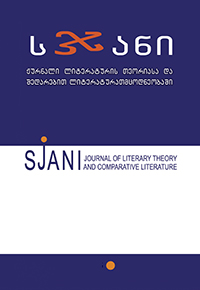ნარცისის მითის სიმბოლისტური გააზრება
Symbolist Interpretation of the Myth of Narcissus
Author(s): Tatia OboladzeSubject(s): Language and Literature Studies, French Literature, Culture and social structure , Psychoanalysis, Theory of Literature
Published by: ლიტერატურის ინსტიტუტის გამომცემლობა
Keywords: The Myth of Narcissus; Symbolism; Tsisperi Qantselebi; Baudelaire; Archetypal Criticism; Intercultural Dialogue;
Summary/Abstract: In the artistic text, the actualization of myth leads to the creation of a universal context and interesting relations between the works composed at different times and places. A new meaning is added to the already existing layers of the myth contents, hence, the myth is revived eternally in the literary area. The Symbolist conceptual model is distinguished by a revival of myth. One of the well-circulated images is Narcissus, re-interpreted from the Modernist perspective. The art circles from the Classical period took interest in this myth, which gave rise to its numerous interpretations. In the last century, due to the discovery of the unconscious, a psychological layer was added to the mythological and literary (generally, artistic) tradition of Narcissus. The complex image of Narcissus proved to be greatly inspirational and topical for Symbolist authors as well. In the Symbolist tradition, the image of Narcissus acquired a metaphysical dimension and became a means of self-reflection for artists. From the 19th c. its “moralized interpretations” gradually disappear, the ontological layer of the myth (beauty, arrogance, erotic self-constraint, punishment, moral, etc.) loses urgency and the image of Narcissus becomes related to the issue of identity, the process of self-knowledge, subjectivism (Strauss 1995).
Journal: სჯანი
- Issue Year: 2022
- Issue No: 23
- Page Range: 300-312
- Page Count: 13
- Language: Georgian

